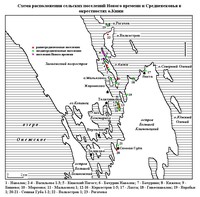Investigations of rural settlements
 @kizhi
@kizhi


In 2000 purposeful works on detecting the locations of historical villages were launched on Kizhi Island under the guidance of K. E. Gherman. Remains of stove sites have been discovered in the villages of Kyazhevo, Bishevo, Bachurino, Morozovo, Dudkin Navolok and Pogost. In 2001 works moved to the neighborhood of Kizhi Island, and remains of stove sites were investigated in the villages of Vorob’i on Bolshoi Klimenetskiy Ostrov, Pod’’elniki and Malkovo on the mainland.
Uncovering and study of medieval antiquities in the neighborhood of Kizhi Island has been conducting since 2001 under the guidance of leading expert on the Middle Ages in Karelia A. M. Spiridonov.
A three-year grant on the theme “Medieval rural settlements of Zaonezhie” (№ 03-01-00056а) from the Russian Foundation for Humanities has become a great help in the work. About two dozens of medieval settlements have been discovered and more than 1000 sq. m of the cultural layer have been investigated for this period. Previously unknown pages in the history of the southern part of Zaonezhie have been opened.
Materials of the early Middle Ages (10 – 12 centuries) are presented in the ancient settlements of Navolok, Kerckostrov 2, 4, Vasilievo 2, Volkostrov 1 and Sennaya Guba 1.
Materials of the advanced Middle Ages (13 – 17 centuries) are presented in the ancient settlements of Navolok, Kerckostrov 1, 3, 4, Vasilievo 1-3, Guives-navolok, Bachurin Navolok, Kizhi Pogost, Vorob’i 1, Rogachevo, Sennaya Guba 1-2 and Malkovets 1. The late Middle Ages are represented, basically, by the materials of the 13th-15th centuries from the ancient settlement of Vasilievo 2. The area of their distribution is 3000 sq. m. The supposition that a strip of land located under the eastern part of the Chapel of the Assumption is the center of the settlement has not been confirmed. Only the excavations of 2006 revealed renovation traces of the heating structure (lots of burned and cracked stones in the 2-4th horizons of the layer, a partially excavated pit filled with a carbon-bearing refractory) though the stove itself was left outside the excavation area.
A cluster of burned stones under the chapel might be taken for the remains of a stove that presumably belonged to the late chapel. In other respects, as reported in previous years, a settlement of the 13-15th centuries could be confidently defined as a possessory village, a center of a boyar patrimony, according to the data of the cadaster of 1582-1583. It is confirmed by an unusual for an ordinary rural settlement set of findings (see the table).
Table 2. Chronology of the Vasilievo 2 ancient settlement in accordance with the dates of finds.
| Finds | Centuries | ||||||
|---|---|---|---|---|---|---|---|
| X | XI | XII | XIII | XIV | XV | XVI | |
| Arrowheads of type 46 (2) | + | + | + | + | |||
| Ice shoes spikes (7) | + | + | + | + | + | + | |
| A hanging bronze ring | + | + | |||||
| An amber pendant | + | + | + | ||||
| Glass bracelets (2) | + | ||||||
| A bronze belt buckle | + | + | |||||
| A bronze signet ring (3) | + | + | + | ||||
| A distaff needle of iron (3) | + | ||||||
| An arrowhead of type 66 | + | ||||||
| A key to the lock of type Д | + | + | |||||
| A silver coin | + | ||||||
Findings of the Modern Age are best represented in the Navolok ancient settlement. They are superior to the number of the Middle Ages findings and are more varied. They represent numerous fragments of wine containers, porcelain and earthenware, among which there are fragments of 30 bottles and shtof-bottles and several china cups and saucers imitating Meissen porcelain. Among the late dining pottery there are fragments from four vessels of black polished Moscow ceramics and fragments from more than 100 thin-walled pots of white and red clay.
Among individual date stamped items there is a collection of copper coins with denominations from quarter Kopek to two Kopeks dated from the period of 1718 – 1861. There are also fragments of a bone chess piece and device used in net making, a pipe shank of white clay, several elements of a door shell, a boot calk, a belt buckle, a hump backed knife of iron and a fish hook.
The Modern Age findings of the Navolok settlement have analogues in collections made during the excavations of the Zemstvo hut in the neighborhood of Tolvuya and the St. Peter's Settlement in the historic area of the city of Petrozavodsk. So, the Zemstvo hut has been located on Kizhi Island from the beginning of the 18th to the middle of the 19th century. It was a local administrative and fiscal center within the Olonets mining district that was subordinate to the Office of the Olonets Peter the Great’s factories in the St. Peter’s Settlement and, later, to the Provincial Administration in the city of Petrozavodsk.
The study of the anthropological composition of the population of the Kizhi parish has been carried out together with specialists of the Museum of Anthropology and Ethnography of the Russian Academy of Sciences since 2005. The obtained results allow us to conclude that there are serious anthropological differences between people of Zaonezhie and other ethnic groups living in the territory of Karelia.
